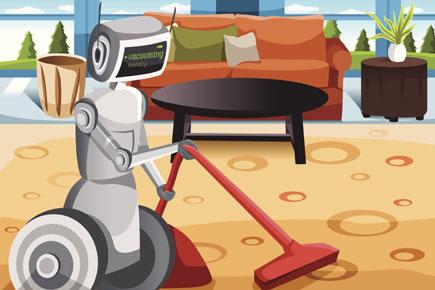Researchers at MIT have developed a wrist-mounted robot that enhances the grasping motion of the human hand

Washington: Researchers at MIT have developed a wrist-mounted robot that enhances the grasping motion of the human hand.
ADVERTISEMENT
The robot works essentially like two extra fingers adjacent to the pinky and thumb. A novel control algorithm enables it to move in sync with the wearer's fingers to grasp objects of various shapes and sizes. Wearing the robot, a user could use one hand to, for instance, hold the base of a bottle while twisting off its cap. "This is a completely intuitive and natural way to move your robotic fingers.

Representational Picture
You do not need to command the robot, but simply move your fingers naturally. Then the robotic fingers react and assist your fingers," said Harry Asada, the Ford Professor of Engineering in Massachusetts Institute of Technology's Department of Mechanical Engineering. Asada hopes that the two-fingered robot may assist people with limited dexterity in performing routine household tasks, such as opening jars and lifting heavy objects.
The robot, which the researchers have dubbed "supernumerary robotic fingers," consists of actuators linked together to exert forces as strong as those of human fingers during a grasping motion. To develop an algorithm to coordinate the robotic fingers with a human hand, the researchers first looked to the physiology of hand gestures, learning that a hand's five fingers are highly coordinated.
While a hand may reach out and grab an orange in a different way than, say, a mug, just two general patterns of motion are used to grasp objects: bringing the fingers together, and twisting them inwards. A grasp of any object can be explained through a combination of these two patterns. The researchers hypothesised that a similar "biomechanical synergy" may exist not only among the five human fingers, but also among seven.
To test the hypothesis, graduate student Faye Wu wore a glove outfitted with multiple position-recording sensors, and attached to her wrist via a light brace. She then scavenged the lab for common objects, such as a box of cookies, a soda bottle, and a football. Wu grasped each object with her hand, then manually positioned the robotic fingers to support the object. She recorded both hand and robotic joint angles multiple times with various objects, then analysed the data, and found that every grasp could be explained by a combination of two or three general patterns among all seven fingers.
The researchers used this information to develop a control algorithm to correlate the postures of the two robotic fingers with those of the five human fingers. "This is a prototype, but we can shrink it down to one-third its size, and make it foldable," Asada said. "We could make this into a watch or a bracelet where the fingers pop up, and when the job is done, they come back into the watch. Wearable robots are a way to bring the robot closer to our daily life," Asada said.
 Subscribe today by clicking the link and stay updated with the latest news!" Click here!
Subscribe today by clicking the link and stay updated with the latest news!" Click here!






